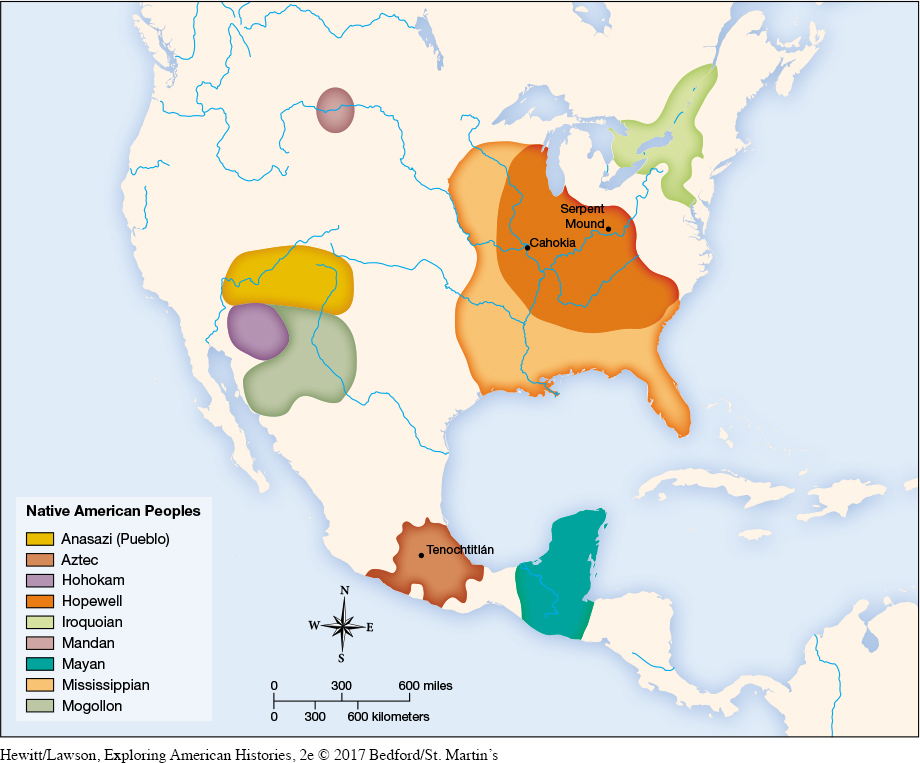Native Cultures to the North
To the north of these grand civilizations, smaller societies with less elaborate cultures thrived. In present-day Arizona and New Mexico, the Mogollon and Hohokam established communities around 500 C.E. The Mogollon were expert potters, while the Hohokam developed extensive irrigation systems. Farther north, in present-day Utah and Colorado, the ancient Pueblo people built adobe and masonry homes cut into cliffs around 750 C.E. After migrating south and constructing large buildings that included administrative offices, religious centers, and craft shops, the Pueblo returned to their cliff dwellings in the 1100s for protection from invaders. There, drought eventually caused them to disperse into smaller groups.
Farther north on the plains that stretched from present-day Colorado into Canada, hunting societies developed around herds of bison. A weighted spear-throwing device, called an atlatl, allowed hunters to capture smaller game, while nets, hooks, and snares allowed them to catch birds, fish, and small animals. These Plains societies generally remained small and widely scattered since they needed a large expanse of territory to ensure their survival as they followed migrating animals or seasonal plant sources. But other native societies, like the Mandan, settled along rivers in the heart of the continent (present-day North and South Dakota). The rich soil along the banks fostered farming, while forests and plains attracted diverse animals for hunting. Around 1250 C.E., however, an extended drought forced these settlements to contract, and competition for resources increased among Mandan villages and with other native groups in the region.

Hunting-gathering societies also emerged along the Pacific coast, where the abundance of fish, small game, and plant life provided the resources to develop permanent settlements. The Chumash Indians, near present-day Santa Barbara, California, harvested resources from the land and the ocean. Women gathered acorns and pine nuts, while men fished and hunted. The Chumash, whose villages sometimes held a thousand inhabitants, participated in regional exchange networks up and down the coast.
Even larger societies with more elaborate social, religious, and political systems developed near the Mississippi River. A group that came to be called the Hopewell people established a thriving culture there in the early centuries C.E. The river and its surrounding lands provided fertile fields and easy access to distant communities. Centered in present-day southern Ohio and western Illinois, the Hopewell constructed towns of four to six thousand people. Artifacts from their burial sites reflect extensive trading networks that stretched from the Missouri River to Lake Superior, and from the Rocky Mountains to the Appalachian region and Florida.
Beginning around 500 C.E., the Hopewell culture gave birth to larger and more complex societies that flourished in the Mississippi River valley and to the south and east. As bows and arrows spread into the region, people hunted more game in the thick forests. But Mississippian groups also learned to cultivate corn. The development of corn as a staple crop allowed the population to expand dramatically, and more complex political and religious systems developed in which elite rulers gained greater control over the labor of farmers and hunters. Mississippian peoples created massive earthworks sculpted in the shape of serpents, birds, and other creatures. Some earthen sculptures stood higher than 70 feet and stretched longer than 1,300 feet. Mississippians also constructed huge temple mounds that could cover nearly 16 acres.
By about 1100 C.E., the Cahokia people established the largest Mississippian settlement, which may have housed ten to thirty thousand inhabitants (Map 1.2). Powerful chieftains extended their trade networks from the Great Lakes to the Gulf of Mexico, conquered smaller villages, and created a centralized government. But in the 1200s environmental factors affected the Cahokian people, too. Deforestation, drought, and perhaps disease as well as overhunting diminished their strength, and many settlements dispersed. After 1400, increased warfare and political turmoil joined with environmental changes to cause Mississippian culture as a whole to decline.

REVIEW & RELATE
Compare and contrast the Aztecs, Incas, and Maya. What similarities and differences do you note?
How did the societies of North America differ from those of the equatorial zone and the Andes?
Exploring American HistoriesPrinted Page 7
Exploring American Histories Value EditionPrinted Page 6
Chapter Timeline